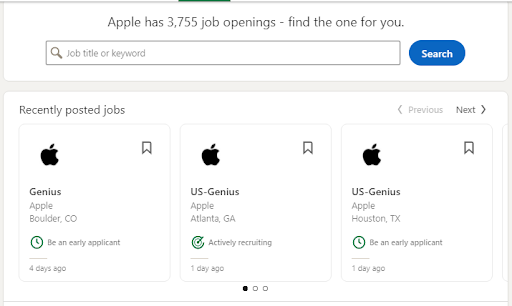The most important resource of a company is its employees. It doesn’t matter if a company has the best equipment, products, or services. Without talented employees who can operate the technology, while marketing and selling it, the company can’t grow.
Finding individuals who are genuinely skilled at certain disciplines, however, can be a challenge. Apart from the fact that they can be a rare resource, you’d have to contend with other companies that are looking to fill vacant positions with the same talent. The good news is, there’s a way you can stand out.
In the following paragraphs, we’re going to explore a few tips that can take your talent outreach up a notch. Let’s go!
1. Identify Your Goals
Before anything else, you need to identify your talent outreach goals. Use the SMART principle to guide your goal-setting strategy. In a nutshell, your goals need to be specific, measurable, achievable, realistic, and timely.

Source: Doug Thorpe
To help you set those goals, ask yourself the following questions:
- What positions do you want to fill?
- Are you recruiting for the short or long-term, full-time or part-time?
- What tangible results (relative to the position in question) are you expecting to reap?
The answers to the questions should guide your talent outreach execution.
For example: if you’re looking to fill an entry-level management position, you should be targeting top universities with reputable MBA courses. In a similar vein, you could consider bringing in the candidate as a consultant if your commitment objective with the position is part-time.
2. Consider Campus Recruitment
There’s no better way to reach out to young, promising talent than through campus recruitment drives. Since many of the world’s prominent colleges and universities have opened up to the idea of direct campus recruitment, you shouldn’t face any opposition when organizing an event like this.
You don’t need to do the recruitment in all schools. Your choice of campuses should depend on what you’re looking for.
For example, if you’re looking for the newest member of your IT team, you may want to hold your event in institutions known for their IT program, such as the Massachusetts Institute of Technology.
The assumption here, though, is that you have a budget to pay the salaries of quality graduates from these types of schools once they are hired. A company that has a budget of $120,000 per year for its entry-level web developer position can direct all of its campus recruitment efforts at top-tier institutions such as MIT. On the other hand, a business that can only afford around $55,000 for the same position is best-served targeting institutions a tier below.
The rationale here is simple: if you don’t have the budget for the salaries top graduates are looking for, you most likely won’t be able to compete with other companies that can offer more during those recruitment drives in the same campus.
In short, you’d only end up wasting your time and resources if you organize a campus recruitment drive there.
3. Organize Competitions
To reach the best talent, why not organize competitions?
Competitions such as hackathons are an effective talent recruitment tool, after all. In Bangalore, India’s Silicon Valley, for example, Google organizes yearly hackathons that pit the best coders against each other. The top finishers get a prize and employment prospects.
Through competitions, you don’t just get to reach your talent prospects. Competitions like these also test crucial skills like logic, critical thinking, analytical aptitudes, research skills, soft skills, and reasoning acuities — all in a high-pressure environment. In other words, if you hire a top finisher in a competition, that person is more likely to excel in the workplace.
These competitions also help to show brands in their best light and sway the career decisions of young, talented individuals. When graduates see your brand frequently contributing to youth development, more of them are likely to want to work with you.
4. Tap Into Social Media
Use social media to reach the best talent out there. Businesses, after all, can no longer ignore social media. LinkedIn, in particular, has nearly 740 million members in more than 200 countries and territories worldwide. That means that talent you’re looking for is more likely on the platform.
So, if your brand doesn’t have a LinkedIn account just yet, create one. Build up your brand’s social media presence with frequent updates on achievements, customer testimonials, and viral infographics. You can even provide learning opportunities for your network. According to Social Media Today, these are examples of highly valuable learning content and events that can get people to notice you:
- Free ebooks, checklists or worksheets
- Live webinars
- LinkedIn live events
- Webinars
- Free consultations
- Virtual LinkedIn local events
- Live coaching sessions
The more involved you are with your audience, the bigger it becomes.

When the time comes, you can leverage that audience to fill vacant roles within your organization. The consumer electronics giant, Apple, is a great example of a company that leverages social media to look for the best talent.
5. Invest in Employee Referral Programs
This is a fairly straightforward tactic: current employees are rewarded for bringing in qualifying candidates – provided the candidates spend a predetermined amount of time in that position. The incentives are usually calculated as a percentage of the salary of the new position and paid out, when due, as end-of-month bonuses in addition to the basic salary.
Employee referral programs are so successful for a reason. Since pre-existing employees know the company culture so well, they’re much more likely to fish out talent that can also gel properly with the company. As a result, these referrals are more likely to stay longer in the company. According to Social Talent, 47% stay for over three years, as opposed to the 14% of hires from job boards who stay for the same period.
So, how do you announce your employee referral program? To start, create a new gmail account separate from the others used for internal communications. This will help you in organization. If you use a separate email address, you won’t have to worry about missing emails about the referral program in your inbox.
Using this dedicated email address, send out a well-crafted message to the entire team on the referral program.
Check out this excerpt from an email from Raizlabs, a mobile development company, on its referral program:

Source: Workable
Specify the terms to prevent things like employees referring those who are not at all qualified for the job.
6. Use a Data-Driven Approach
Data is the currency of the 21st century. Data gives you important insights you can use to improve strategies. That applies to your talent outreach, too.
So, why not ask applicants for feedback? Ask them what graduates think about you as an employer. Do they think you need to be more involved in the community? Maybe they think the hiring process takes too long. Assess their answers and make the necessary adjustments. The idea is to improve your image based on their feedback so more talent will want to work with you.
Check out what other data is telling you, too. For example, if you see many of your new hires who are doing great in the workplace are sourced from employee referrals, then you might want to invest a lot of your efforts there. If they were sourced from social media, then give your social media accounts more attention.
Pay attention to the data because it can tell you a lot about what you’re doing right and what you’re doing wrong. You can improve your strategy to fish out the best talent based on what you find.
Bottom Line
Companies are spending increasing amounts of time and money to get the right talent for every vacant position. That’s because they understand that employees are crucial cogs in the organizational wheel.
There is, however, a way for you to stand out as an employer and get the best talent out there.
Leverage campus recruitment drives and social media platforms to reach talent prospects. Organize competitions to weed out competent individuals while doing something noteworthy for your community. Also, always assess the available data for actionable insights to improve your recruitment strategy.
Do all these things and you’ll perfect your talent outreach.
Here’s to finding the best talent for your organization!
About the Author
 David Campbell is a digital marketing specialist at Ramp Ventures. He helps manage the content marketing team at Right Inbox. When he’s not working, he enjoys traveling and trying to learn Spanish.
David Campbell is a digital marketing specialist at Ramp Ventures. He helps manage the content marketing team at Right Inbox. When he’s not working, he enjoys traveling and trying to learn Spanish.











